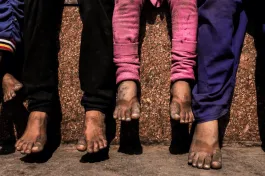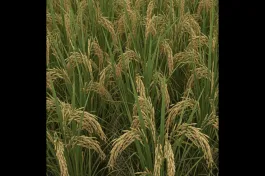The government primary school in Ejamar is at a walking distance from the block office in Manika, Latehar district. This is a single-teacher school, where a majority of children are from Dalit or Adivasi families. The single teacher has to manage multi-grade teaching for 88 pupils, apart from administrative duties.
The school lacks basic infrastructure and facilities like electricity, drinking water, functional toilets, a boundary wall, and a playground. Huddled in two dingy classrooms with the barest furniture, 88 little ones study at Ejamar in the hope of a brighter future. These students – with no education for two years during the Covid-19 crisis – could not recall the last time they had eaten an egg with their midday meal. This is supposed to happen twice a week in Jharkhand’s primary schools.
This gloomy picture could be true of many other government schools in Jharkhand. This is not to say that they all fall short of the basic standards of a good school, but that most of them are far from exemplary. Despite the Right to Education Act affirming children’s fundamental right to free and compulsory education until the age of 14, government schools in Jharkhand fall woefully short when it comes to providing quality education.
This is not to deny that schools in Jharkhand have improved from their earlier, even more dismal state. The Public Report on Basic Education (PROBE) and the follow-up PROBE Revisited, published in 1996 and 2006 respectively, give a sense of the changes that took place over that period.
The state government switched to online education, replacing physical classes with WhatsApp groups and YouTube lessons. Yet the Department of School Education and Literacy found that 65% of its students did not have access to a smart phone.
In Jharkhand, as elsewhere, the reach of government schools expanded and their infrastructure improved. Teacher absenteeism fell, more facilities became available, including electricity and toilets, and many schools started providing free learning material. Reports also showed that poor families in rural Jharkhand were keen to send their children to safe and affordable schools. They understood the key role that education plays on the road to freedom. Many things looked better in 2006 than 10 years earlier, but plenty of gaps remained.
During the Covid-19 crisis, government primary and upper primary schools in Jharkhand remained closed for nearly two years. The state government switched to online education, replacing physical classes with WhatsApp groups and YouTube lessons. Yet the Department of School Education and Literacy found that 65% of its students did not have access to a smart phone.
The limitations of online education were brought out in another report on school education, Locked Out (published in late 2021). This report is based on a country-wide survey of 1,200 relatively poor households. Only 8% of parents with children enrolled in government schools felt that their child had adequate online access. Almost 40% of the children surveyed in rural areas were not studying at all. The pandemic-induced learning loss was massive, with almost 42% of rural students in grades 3–5 unable to read more than a few words.
Post-Covid-19 schooling
With this background, the Gloom in the Classroom report (released in late 2022) examined the post-Covid-19 schooling situation in Jharkhand. It presented the findings of a survey of 138 randomly selected primary and upper primary government schools, conducted by the Bharat Gyan Vigyan Samiti, Jharkhand.
The sample schools were spread across 30 blocks in 16 districts and were selected from amongst those that had at least 50% Dalit or Adivasi student enrolment. The survey looks at the structural inadequacy of the schooling system in Jharkhand and also at the more recent consequences of the Covid-19 crisis. The report card gives an idea of how things are in primary schools.

Government schools in Jharkhand continue to be severely short of teachers, have poor infrastructure, and do not have sufficient funds for midday meals and other incentive schemes. One symptom of the shortage of teachers is the large proportion of single-teacher schools: 20% of all schools in our sample, and 35% of the primary schools. This finding is consistent with state-level UDISE data for Jharkhand, which shows that 30% of all primary schools in the state have a single teacher. This is a blatant violation of the Right to Education Act.
“Due to having a single teacher in the school, if the teacher leaves, the school must be shut down.”
– Harilakol, school teacher, Dhanbad district
To reduce teacher shortages, the Jharkhand government has hired many contract teachers over the years. According to the Right to Education Act, hiring rules can be relaxed for a period of at most five years to allow teachers to be hired on a non-regular contract at a fraction of the regular salary. Once hired, these teachers should be provided with ample opportunities to upskill themselves and become regular employees.
Contrary to these norms, the survey interviews suggest that contract teachers have few opportunities to upskill themselves or achieve job security. Not only does this create a dual teacher cadre, it also forces many government schools to depend on under-skilled teachers. As many as 40% of the primary schools in our sample were run by contract teachers. These issues deepen further in schools with just Dalit and Adivasi students.
Electricity supply was a little better, with 46% of primary and 68% upper primary schools having a functional connection. But in many schools that had a connection, the fans and tube lights were missing.
According to the Right to Education Act, primary and upper primary schools should maintain a pupil-teacher ratio (PTR) of 30 at most. That is, for every 30 students there should be one teacher. But only 36% of all schools in our sample (53% of primary schools and 19% of upper primary) had a PTR below 30. Based on the survey data, the report estimates that the number of primary and upper primary school teachers in Jharkhand needs to be doubled if every school is to comply with the PTR norms.
“Despite being a middle school with 110 students, there is only one teacher. The teacher is unable to give time to the students properly.”
– Sirsiya, Giridih district.
In comparison with UDISE data for Jharkhand, most schools in our sample fared quite badly on infrastructure. About half of the primary and less than half of the upper primary schools had functional water supply. In other schools, the water supply was poor, non-functional, or non-existent.
“Water supply is from a hand pump which does not work most of the time. Toilets are dysfunctional and there is no boundary wall or playground.”
– Majdiha, Dumka district.
Electricity supply was a little better, with 46% of primary and 68% upper primary schools having a functional connection. But in many schools that had a connection, the fans and tube lights were missing. Only 41% of primary and 43% of upper primary schools had good toilets, respectively.
“The toilets had bushes growing inside and it felt like they had not been used since they had been constructed.”
– Saruka, Deogarh district.
The proportion of schools without boundary walls and playgrounds was quite high as well. Nearly two-thirds of primary schools and 39% of upper primary schools were without a boundary wall. The numbers were similar for playgrounds, with 64% of primary schools and 45% of upper primary schools without them.
“Due to a lack of a boundary wall, animals keep entering the school premises. Sometimes wild elephants even come in. This causes some danger to the students during school hours.”
– Bogai, Ramgarh district.
Shortage of classrooms forces multi-grade teaching, which is very inadequate for first-generation learners. Our sample found that primary schools with an average of 54 students had only two classrooms, while upper primary schools with an average of 210 students had only five classrooms.
“There is water seepage from the ceiling in one of the two classrooms. Students from KG to Class 5 all sit in the same classroom.”
– Bairia, Palamu district.
Another issue that emerged from the survey is that of delayed salary payments to most school employees other than permanent teachers. Contract teachers were owed three months salary on average at the time of the survey, and midday meal cooks (paid a pittance of Rs 2,000 per month) often remained unpaid for more than six months.
Midday meal funds are also starved of money. The funds are supposed to be provided at the beginning of every quarter, but this rarely happens, forcing schools to borrow money for midday meals. Sometimes, the separate “egg fund” is used to buy vegetables and pulses.
We asked the respondent teachers whether they felt that some students in classes 3 to 5 had forgotten to read and write when schools reopened. Not one of them said no.
Most respondent teachers (90%) claimed that eggs were being provided twice a week, but informal conversations with parents or children often revealed that this was not the case. It was quite common for a school to provide eggs less than twice a week, and a minority of teachers (10%) admitted as much. In three schools, eggs were not provided at all.
“MDM funds have run out. The principal spends from her own pocket to keep the midday meal going. Kids are complaining that the meal is not good.”
– Karwakala, Garhwa district.
The discontinuation of physical classes during the Covid-19 crisis has created a troubling situation for many students who have forgotten their basics in arithmetic, reading, and writing. We asked the respondent teachers whether they felt that some students in classes 3 to 5 had forgotten to read and write when schools reopened. Not one of them said no. More than half claimed that “most” of the students at that level had forgotten to read and write by the time schools reopened.
In spite of this, no substantial measures had been initiated by the state government to help these students to recover, except for the introduction of “foundational literacy and numeracy” (FLN) textbooks for grades 1 to 3. It is unlikely that new textbooks alone can pull Jharkhand’s students out of the dire straits they are in.
Another consequence of the Covid-19 crisis is low levels of pupil attendance. On the day of the survey, average pupil attendance was just 68% in primary schools and 58% in upper primary schools. In a well-functioning school, pupil attendance should be close to 100% and certainly above 90%.
But only 28% of primary schools and a diminutive 12% of upper primary schools in our sample had at least 80% attendance on the day of the survey. Whether this is because children have lost the habit of going to school, or because the school conditions are so dismal that they cannot find the motivation to attend regularly is hard to say.
In Jharkhand, children from Adivasi and Dalit families generally study in government schools at the primary and upper primary levels. These families often have little money to spare for their educational pursuits, and send their kids to a government school despite being quite aware that there would be little teaching there. At least they are provided with a meal there, and perhaps even eggs.
It is true that some students with elder siblings or an educated relative manage to pull through and complete their schooling. But a large number step out of the schooling system before even reaching class 5. This can be seen in the pattern of depleting enrolment in successively higher grades.
The Department of Education continues to be more concerned with transfers, contracts, procurement … than with what is happening to children in schools.
The most troubling aspect of this crisis is the silence that surrounds it in public forums. The victims have no voice and no power. Children from privileged families have taken refuge in expensive private schools and the schooling system is working fine as far as they are concerned.
Underprivileged children, for their part, count for very little in the designs of policy makers and political leaders. The Department of Education continues to be more concerned with transfers, contracts, procurement, and record-keeping than with what is happening to children in schools. As for political leaders, they have shown very little interest in elementary education in Jharkhand.
Conclusions
The dismal state of the schooling system in Jharkhand reflects decades of state apathy towards elementary education. This apathy is both a mistake and an injustice. It is a mistake because quality education for all could transform the economy and society of Jharkhand. It is an injustice because it keeps oppressed classes and communities where they are.
Development should go hand in hand with ethical progress and social justice. Education is a crucial tool in that journey. With every passing day of the schooling crisis, we are denying children a constitutional right to better opportunities and preparing them to drop out. Everyone must wake up and make a noise about this.
Paran Amitava is an independent researcher studying the schooling system in Jharkhand.









